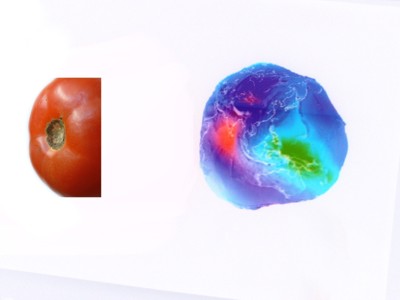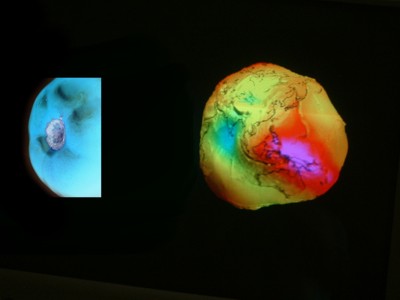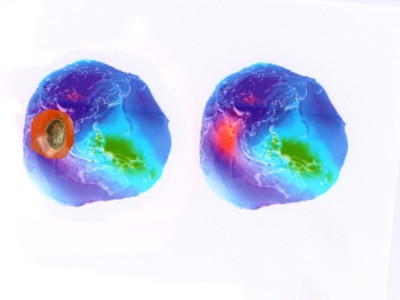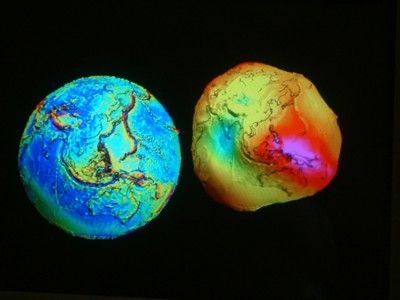https://translate.google.com/translate
is not so accurate to other languages
OUR EARTH IS HUGE EGG CELL, NOT A
PLANET AS WE HUMANS CALL IT,
IT IS SAME AS ANY ANIMAL OR HUMAN FEMALE EGG OR
CELL SPERM.
Written by Rudolf Bosnjak - September 2005
OUR SUN, EARTH and ALL OTHER PLANETS ARE SIMPLY REGULAR SO
HUGE EGG CELL.
I will use ACCEPTED word terms as we well know them on this planet TO COMPARE and
EXPLAIN.
Something strange has been going on under
our feet for the past four years. Earth's gravity field suddenly shifted gears and began
getting flatter, reversing a course of centuries during which the planet and its gravity
field grew rounder each year.
The scientists who noticed the change and report
it in the Aug. 2 issue of the journal Science suspect Earth itself may be
flattening out, with the oceans rising near
the equator, but they aren't sure.
What they do know is that Earth has never been
round. It has always bulged at the equator and is about 0.3 percent fatter there, partly a
result of the planet's rotation.
Images you will see here are sources TAKEN from different web sites and
many scientific projects, from SOHO, NASA, different weather satellites and many
other human projects on this planet, and ALL IS COMPILED as my NEW THEORY with name OUR EARTH IS HUGE CELL AS HUMAN FEMALE EGG OR CELL SPERM.
WHAT IS THIS ALL ABOUT. WHAT WE NAMED, WHAT WE HUMANS SEE AND FEEL AND
ACCEPT AS UNIVERSE, GALAXIES, GENETICS, OPTIC INVISIBLE AND VISIBLE SPECTRUM, AS
RADIO FREQUENCY SPECTRUM, INFRA AND ULTRA SOUND AND IMAGES FROM GRAVITY ANOMALIES OF
PLANET EARTH WE JUST DISCOVER IN LAST FEW YEARS. AND SOME STILL NOT KNOWN SPECTRUMS AS
NEGATIVE AND POSITIVE.
TO UNDERSTAND NEGATIVE AND POSITIVE IMAGE
JUST SEE YOUR OWN IMAGE IN THE MIRROR, WHAT YOU SEE THERE, YOU SEE YOUR
OPPOSITE IMAGE, REVERSED, WHAT IS LEFT IS RIGHT WHAT IS RIGHT IS LEFT. WE
NAMED THAT MIRRORED IMAGE, BUT MISSING SOME THINGS THERE... MISSING OPPOSITE COLOR!!!!!!!!!!!! YES.
WHAT IS OPPOSITE COLOR I HOPE YOU WILL
UNDERSTAND AFTER VIEW ALL MY WORK AND SOME CONCLUSIONS. PLEASE READ AND THINK, IS THIS IS
POSSIBLE, I THINK YES. IF YOU COME TO THE SAME CONCLUSION PLEASE SHARE THIS WEB PAGE WITH
OTHERS TO READ AND TRY TO REACH LEVEL OF UNDERSTANDING SHOWN HERE.
First what reader must accept to understand
this theory is to know what kind of being is EARTH, Male or Female.
Second what reader must accept to understand
this theory is to know who carrying and laying eggs. We
know that process was done from female. But even MALE CAN CARRY EGGS IN THEIR SKIN, EVEN,
NOT TO KNOWING DOING THIS. Read here soon about this process.
| CHICKEN EGG EXPLANATION |
|
air cell - an
empty space located at the large end of the egg; it is between the inner and outer shell
membranes. |
|
| yolk
- the yellow, inner part of the egg where the embryo will form. The yolk contains
the food that will nourish the embryo as it grows. chalaza
- at the one side, a spiral, rope-like strand that anchors the yolk in the thick egg
white.
albumin - the egg white when cooked or baked, but is
transparent liquid. |
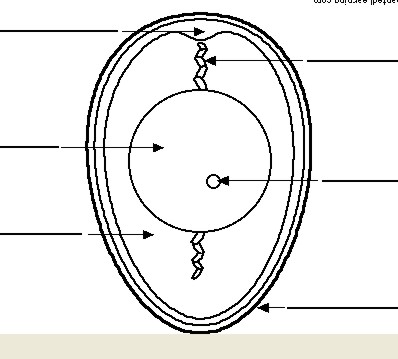 |
chalaza
- at the one side, a spiral, rope-like strand that anchors the yolk in the thick egg
white. There are two chalazae anchoring each yolk; one on the top and one on the bottom.
(The plural of chalaza is chalazae.) germinal disc
- a small, circular, white spot (2-3 mm across) on the surface of the yolk; it is where
the sperm enters the egg. The nucleus of the egg is in the blastodisc.
shell - the hard, protective coating of the egg. It is
semi-permeable; it lets gas exchange occur, but keeps other substances from entering the
egg. The shell is made of calcium carbonate |
|
|
|
CHICKEN EGG DETAILS AND EXPLANATION |
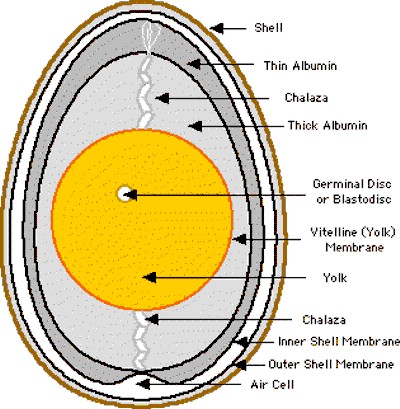
|
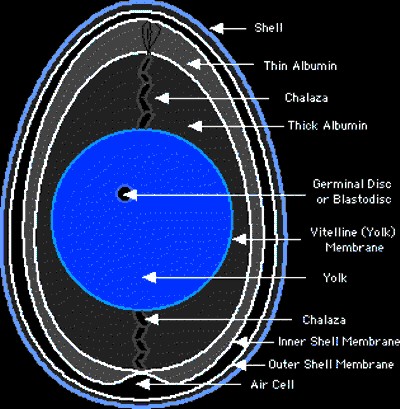
|
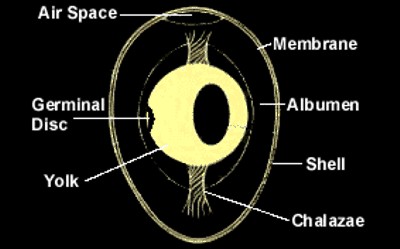 |
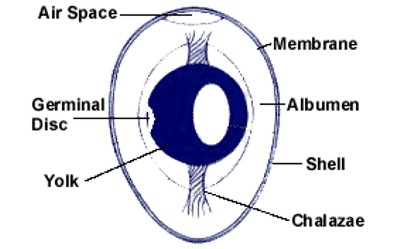 |
This is POSITIVE image of INSIDE EGG. |
This is NEGATIVE image of INSIDE EGG. |

|

|
This is POSITIVE image of Yolk. |
This is NEGATIVE image of Yolk. |
|
|
PLANET EARTH GETTING ROUNDER
Yet ever since the last Ice Age, the planet has been getting rounder as ground beneath
the polar regions, relieved of the weight from ice that was miles thick in places, has
been rebounding. In some parts of Scandinavia and Canada, the ground rises a quarter-inch
(1 centimeter) per year.
Since the late 1970s, satellite measurements have shown that this post-glacial rebound,
as it is called, generates a corresponding rounding of Earth's gravity field.
Suddenly the trend has reversed.
"Sometime around 1998, something began to make the Earth's gravity field
flatter," says Christopher Cox of Raytheon Information Technology and Scientific
Services. "The result is it looks as if post-glacial rebound has reversed itself.
But, we do not have any reason to think that post-glacial rebound has in any way stopped
or changed."
In effect, Cox said in an interview, while post-glacial rebound continues to make the
Earth rounder, some movement of mass on the surface of the Earth must be making the
gravity field flatter. It's not a change anyone could notice; it's only revealed by
sensitive satellite measurements.
The shift, however, is significant.
"The effect is twice as large as post-glacial rebound in terms of effect on the
gravity field, and it's in the opposite direction," Cox said. "Whatever it is,
it's big."
Like a rubber ball
Cox, who also works at NASA's Goddard Space Flight Center, described post-glacial
rebound as similar to pushing a rubber ball in at the top and bottom with your fingers.
"The sides come out, and the top and bottom go in. Take your fingers off that rubber
ball, and the sides are going to go in and the top is going to come out again."
What does this have to do with Earth?
"You have material moving inside," Cox explained. The rubber is compressed,
but air is also pushed around. Some of the post-glacial rebound is caused by the ground
simply decompressing. But scientists have long known that to account for what they've
measured, Earth's physical shape must change. Material --ground, water or air -- must be
moved around. Though the planet's shape and its gravity field are not directly correlated,
they are related.
Cox and his colleague, Benjamin Chao of Goddard, were at first baffled by the sudden
reversal and flattening of the gravity field. They considered that ice melting at the
poles and raising the overall sea level could be the culprit. Calculations showed,
however, that "you would have to drop a 10x10x5 kilometer cube of it into the ocean
every year for the past five years." Separate measurements of sea surface height from
NASA's TOPEX/Poseidon mission don't support this scenario.
Material in Earth's crust can't be responsible -- it couldn't move so quickly from the
poles to the equator. Molten rock oozing around in Earth's core might be to blame, but
data do not support such a scenario. Changes in the atmosphere might be involved, but no
data supports that being the primary cause, either.
So what is it?
Instead, Cox said, long-term circulation patterns in the ocean seem to be the most
likely cause.
Shifts in huge ocean currents -- similar to El Nino but on larger scales and moving in
a north-south direction -- might transport enough water toward the equator to account for
the flattened gravity field. One such cycle is called the Pacific Decadal Oscillation.
"We have a strong suspicion that it's in the ocean," Cox said.
"Whatever the cause, the results of Cox and Chao emphasize the importance of
gravity variations as a barometer of integrated mass changes in the Earth system,"
write scientists Anny Cazenave and R. Steven Nerem in an analysis of the research for Science.
"Monitoring these variations with improved spatial and temporal resolution would
provide an important tool for studying Earth system changes."
Since Cox and Chao submitted their paper to the journal, they've continued to look into
the mystery and are more confident that the ocean is behind it all. "But we need more
data," Cox said.
That data could come from NASA's GRACE
(Gravity Recovery and Climate Experiment) satellite mission, which will provide the most
precise measurements ever made of Earth's gravity field. GRACE launched in
March.
August 01, 2002 - (date of web publication)
SATELLITES REVEAL A MYSTERY OF LARGE CHANGE IN
EARTH'S GRAVITY FIELD
Satellite data since 1998 indicates the bulge in the
Earth's gravity field at the equator is growing, and scientists think that the ocean may
hold the answer to the mystery of how the changes in the trend of Earth's gravity are
occurring.
Before 1998, Earth's equatorial bulge in the gravity
field was getting smaller because of the post-glacial rebound, or PGR, that occurred as a
result of the melting of the ice sheets after the last Ice Age. When the ice sheets
melted, land that was underneath the ice started rising. As the ground rebounded in this
fashion, the gravity field changed.
"The Earth behaved much like putting your finger
into a sponge ball and watching it slowly bounce back," said Christopher Cox, a
research scientist supporting the Space Geodesy Branch at NASA's Goddard Space Flight
Center, Greenbelt, Md.
Currently, the Earth has a significant upward bulge at
the equator, and a downward bulge at the poles. "Observations of the Earth's gravity
field show that some phenomena are counteracting the gravitational effects of PGR. Whereas
PGR has been decreasing the bulge in the Earth's gravity field at the equator, this recent
phenomena is causing the bulge to increase," Cox said. Such changes in the gravity
field can be sensed using ultra precise laser tracking of satellites to observe tiny
changes in the orbits of those satellites and by tracking changes in the length of day or
rotation of the Earth.
Scientists believe movements of mass cause this recent
change from the high latitudes to the equator. Such large changes may be caused by climate
change, but could also be part of normal long-period climatic variation. "The three
areas that can trigger large changes in the Earth's gravitational field are oceans, polar
and glacial ice, and atmosphere," Cox said.
Cox and colleague Dr. Benjamin Chao have ruled out the
atmosphere as the cause. Instead, they suggest a significant amount of Ice or water must
be moving from high latitude regions to the equator, and oceans could be the vehicles of
this movement.
Estimates of today's glacier and polar ice melting are
too small to explain the recent changes in the gravity field. If melting ice were the
cause of the recent changes in the gravitational field, it would require melting a block
of ice 10 km (6.2 miles) on each side by 5 km (3.1 miles) high every year since 1997 and
pouring it into the oceans.
"The recent reports of large icebergs calving in
Antarctica can't explain this, because they were already floating in the ocean," Cox
said. Further, radar altimeter observations of the average sea level rise provided by the
TOPEX/POSEIDON satellite show no corresponding change in the rate of the global sea level
increase.
Consequently mass must have been redistributed within
the oceans. That's where the ocean circulation theory comes in. Ocean currents can
redistribute mass quickly, such as the 5-year time frame that these changes were first
observed. The TOPEX/POSEIDON observations of sea level height do show an increase in the
equatorial bulge of the oceans corresponding to the observed gravity changes, but the data
are not yet conclusive. One critical factor is the temperature of the world's oceans, and
its salinity, for which detailed data are not yet available.
In 2002 NASA also launched the GRACE and JASON missions,
missions that will help to more precisely track these sorts of changes in Earth’s
geodesy, and will launch the ICESAT mission this winter.
An article on this NASA-funded study appears in the
August 2 issue of the journal Science.
Images below is how complete EARTH
scientific astronomy community seeing, EARTH. This is actually twisted invisible energy
for human eyes and our technology instruments.
| What we STILL LEARNING ARE OPINIONS THAT
we know WHAT this same shape AS EARTH IS (air) cell - an HUGE CIRCULAR ICE BALL
SHAPE space located at the MIDDLE or at one end of the EARTH; it is ON THIS IMAGE ON THE
LEFT BOTTOM AS of visible FAST OR SLOW FROZEN AIR IN BULB -YOLK. If this
happening SLOWLY rotating water bulb in time of water freezing, as we know water start to
freezing from outside and inside of frizzed water stay AIR, yes inside is AIR.... under
some pressure from ICE WHO ascending in side and outside.
Now, imagine in your mind that ball of water is located somehow in the UNIVERSE-SPACE
where no "gravitational force" force to pull that AIR on one side, as is visible
on bottom image. This experiment I do in my own refrigerator, for that reason I did not
produce IDEAL FROZEN ICE BALL, but I am sure in nice laboratory and conditions this
can be done very easy.l |

|

|
This is POSITIVE image of ICE BALL as frozen water and
is visible AIR BULB inside as -Yolk. |
This is NEGATIVE image of ICE BALL as frozen water and
is visible AIR inside as -Yolk. |
MIRROR
IN SIZE |
ATTENTION:
BELOW IMAGES ARE GRAVITATIONAL FIELD MEASUREMENTS AND ALL THIS IS A HUGE EGG CELL |
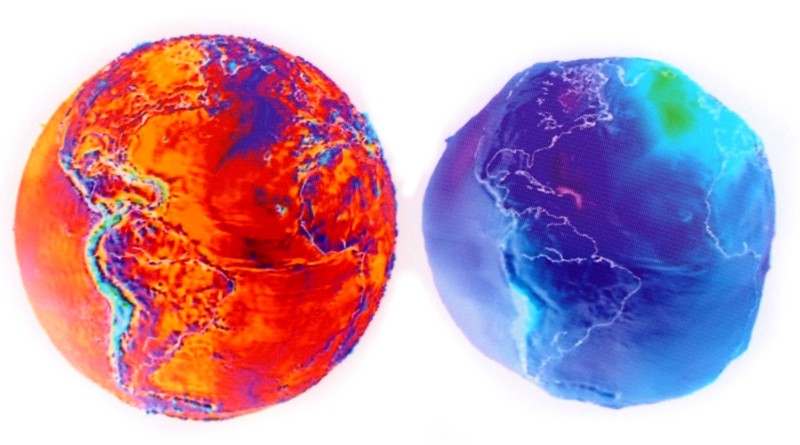
|
IMAGES OF GRAVITATIONAL FORCE OF PLANET
EARTH |
 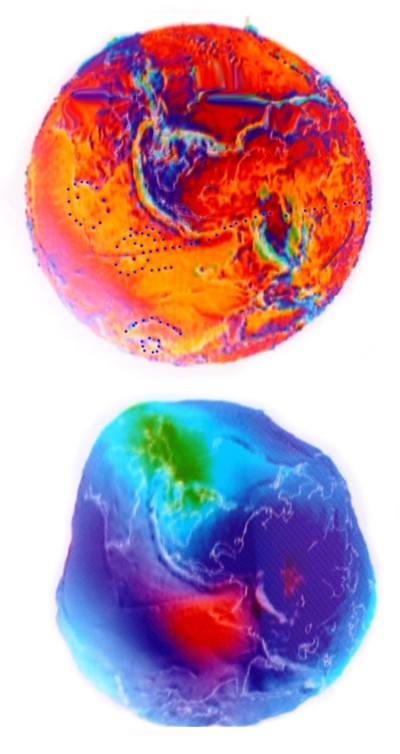 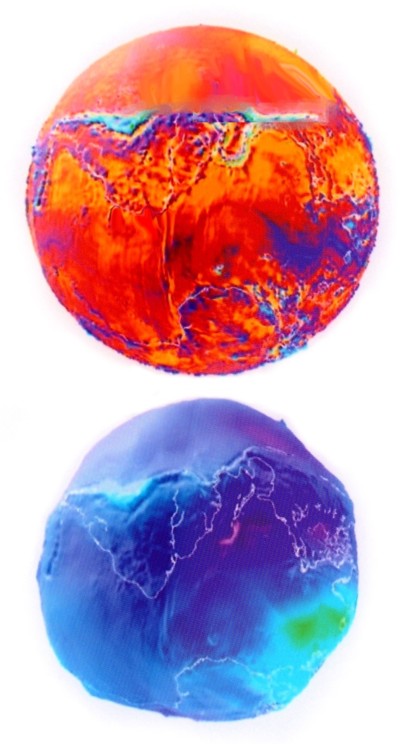
|

|
ABOVE IS
EXAMPLE OF POSITIVE AND NEGATIVE IMAGE OF CHICKEN EGG AND EARTH GRAVITATIONAL IMAGE WHAT
LOOKS EXACTLY AS EGG. |
MENSTRUAL CYCLE or EARTH PERIOD
What is the menstrual period of woman. We know that is 28-29
days depending on some conditions. What is menstrual period of EARTH. Is this menstrual period when all not used eggs are released to the
surrounding space. Where all this eggs go? We call this HURRICANE, TORNADO, TAIFUN,
URAGAN... THOSE ARE ENTRY or EXIT VORTEX...
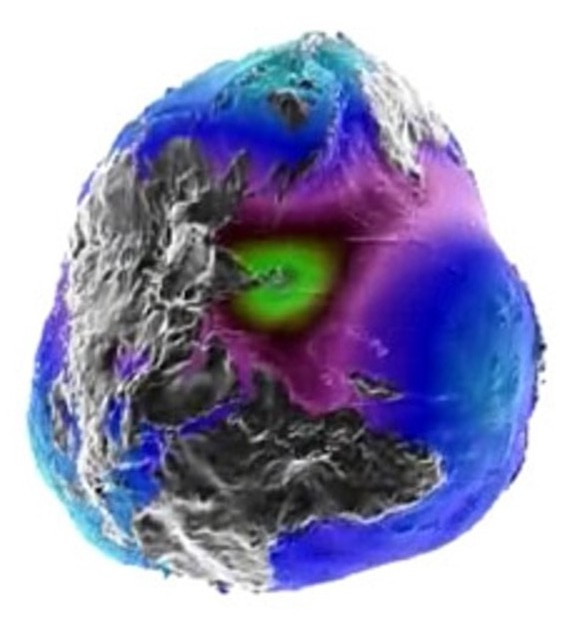
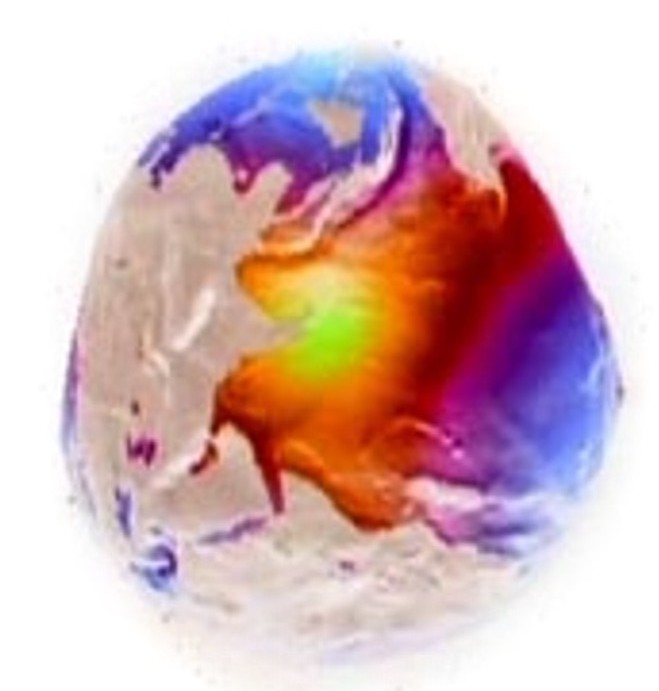
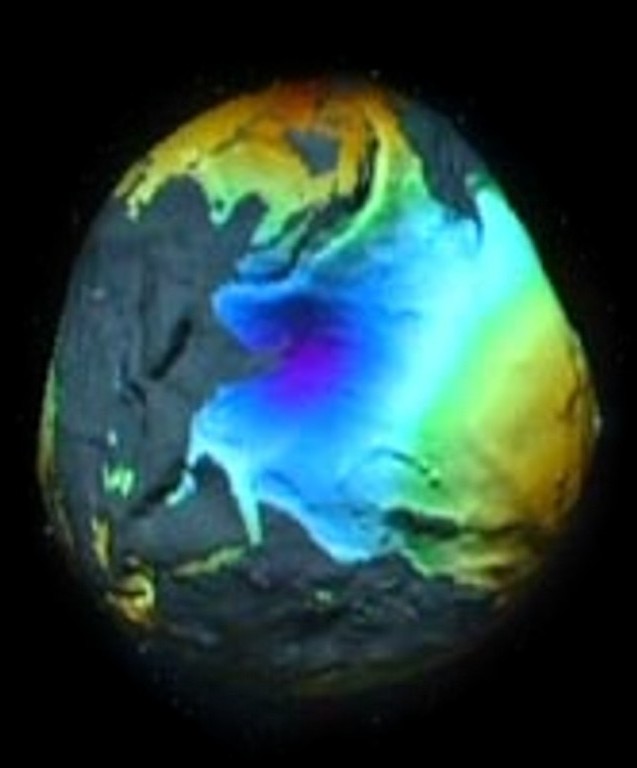
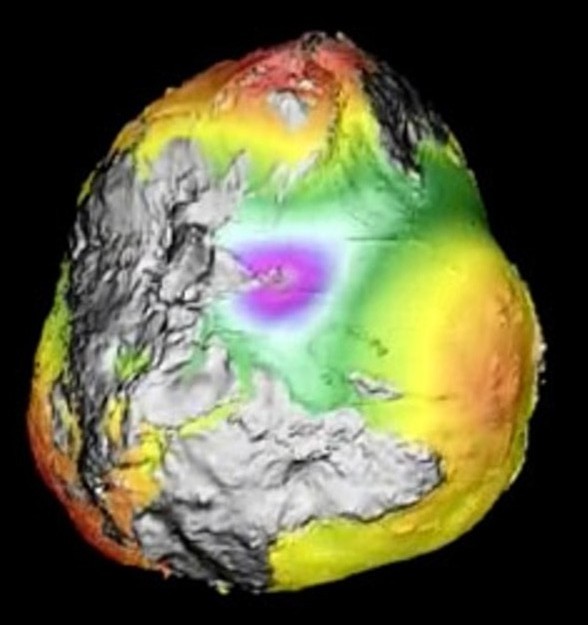
NOW, IF MY
"SCIENTIFIC" THEORY IS CORRECT, WHO IS SPERM, WHERE IS SPERM LOCATED AND WHERE IS DONOR OF SUCH A HUGE SPERM?
WHAT IS SPERM WHO FERTILIZE EARTH
EGG, OR EARTH EGG IS ALREADY FERTILIZED EVERY TIME WHEN WE HAVE KIND OF HURRICANE,
TORNADO, TAIFUN, URAGAN or EARTHQUAKES and THOSE ARE
ENTRY or EXIT VAGINA VORTEX...
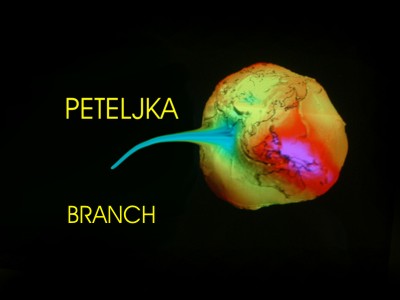
If, Rudolf Bosnjak theory
is correct,
CITIZENS OF PLANET EARTH
can expect new "baby" delivery from mother
EARTH...
BABY MUST COME OUT AND WHERE IS
THIS PLACE ON THIS PLANET...
If you watch carefully above images
and below animation, you can see where is INVISIBLE EARTH
STOMACH and where is INVISIBLE EARTH VAGINA EXIT, and where IS INVISIBLE TWO EARTH "LEGS" FROM
EARTH SPHERE, in position like an woman baby delivery...
SEE HERE MY ANIMATION where is EARTH
VAGINA EXIT, and I hope you can understand what can happened to humans after this "baby" delivery... Date for delivery I do not know, but if you know what happened with woman,
will be the same symptoms but so huge...
If, this place in Indian ocean is
wrong selected, as is here described, can be any other on place, use you brain power to
find it.
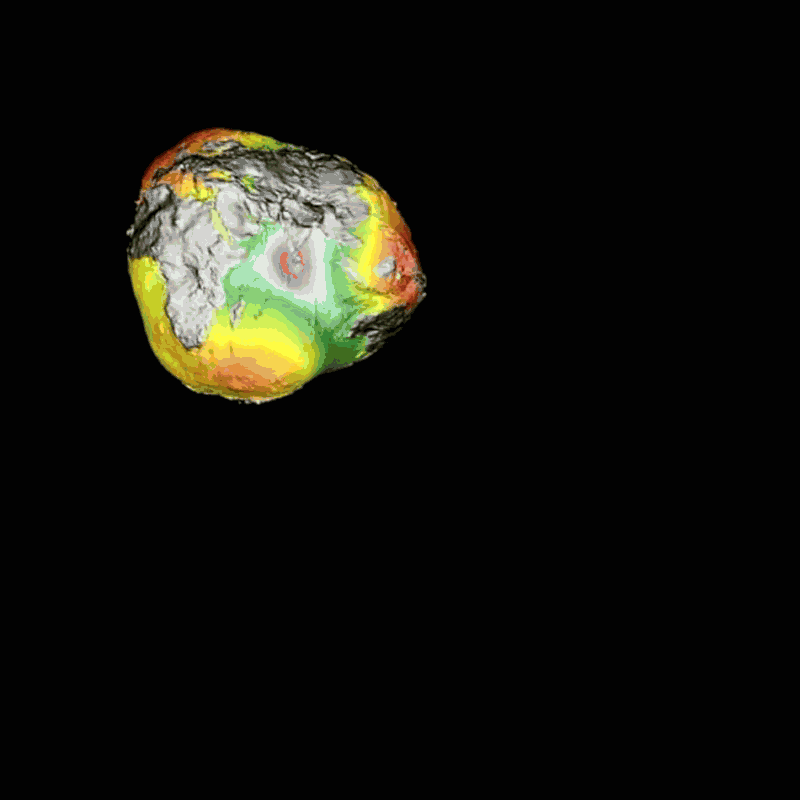
THIS IS MY VIEW OF FUTURE DELIVERY
TO THE SURFACE OF OUR PLANET AN NEW "BABY". I TAKE IN ACCOUNT ALL WHAT I KNOW UNTIL TODAY 18 NOVEMBER 2005.
YOU HAVE TO KNOW THAT THIS POINT
WHERE IS EARTH VAGINA IS IN DEEP PLACE BELOW INDIAN OCEAN AND THAT IS THERE FEW HUNDRED
METERS OF WATER, EVEN 1 KILOMETER OF WATER, WHICH WILL PREVAIL UP AS SO HUGE GIGANTIC TSUNAMI WHEN THIS "BABY" WHAT EVER IT IS AND START TO
COME OUT. EVEN I DID NOT MENTION ANY EARTHQUAKE WHAT WILL FOLLOW IN THE MEAN TIME. THERE IS ONLY ONE EXPLANATION IN THE BIBLE ABOUT GREAT FLOODING...
WE, HUMANS EVEN CAN NOT IMAGINE
WHAT DAMAGE WILL BE.
Thank you for your time and attempt to see this and think about.
Regards
Rudolf Bosnjak
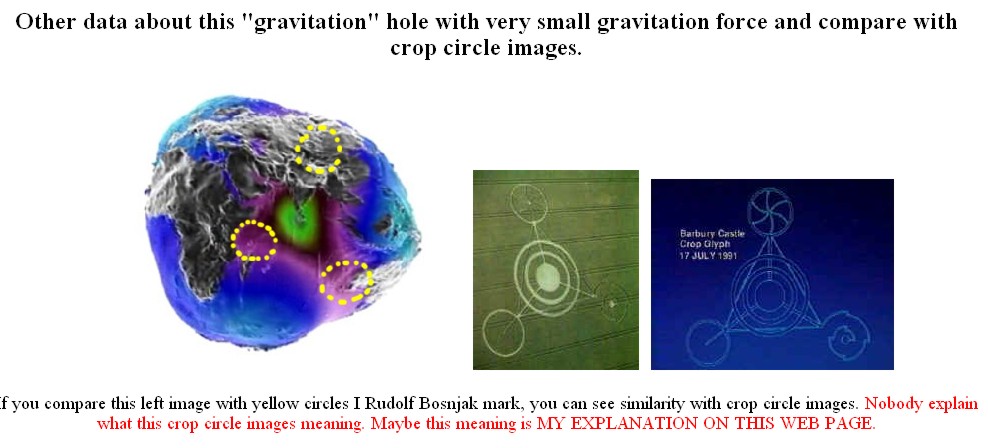
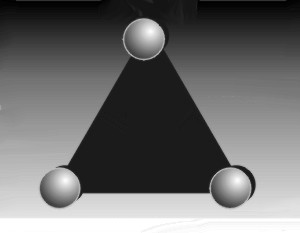


Compare this with mason sign - pyramid, what you can conclude?
Electric field vortex is exit or
entrance: FOR WHAT?
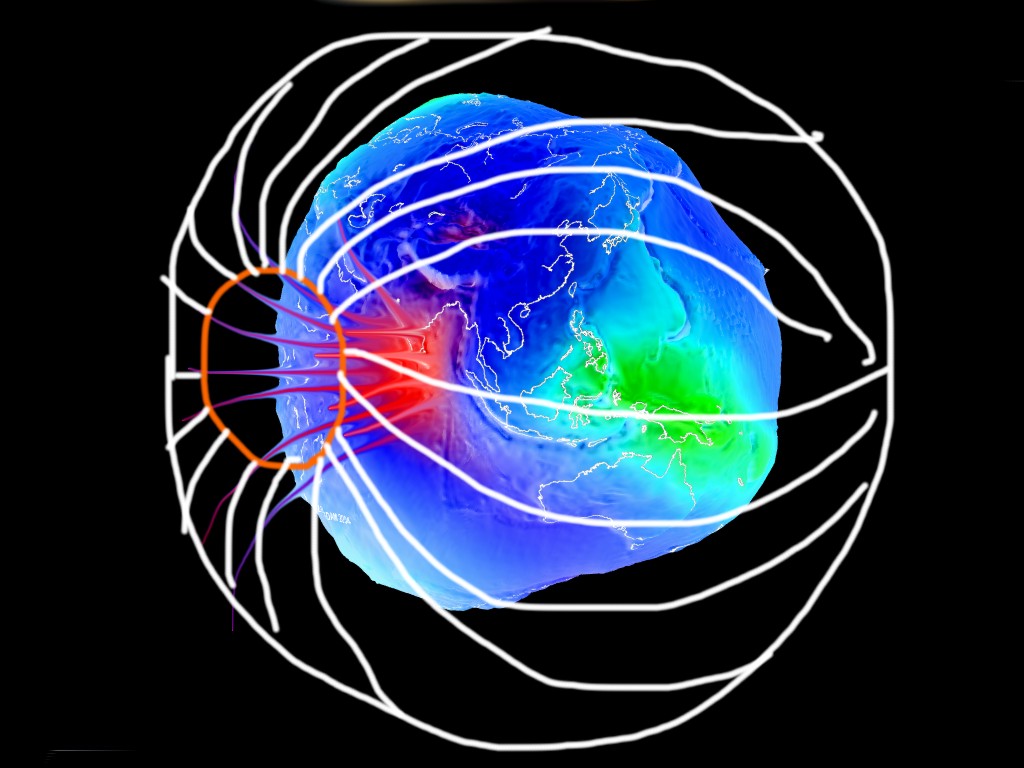
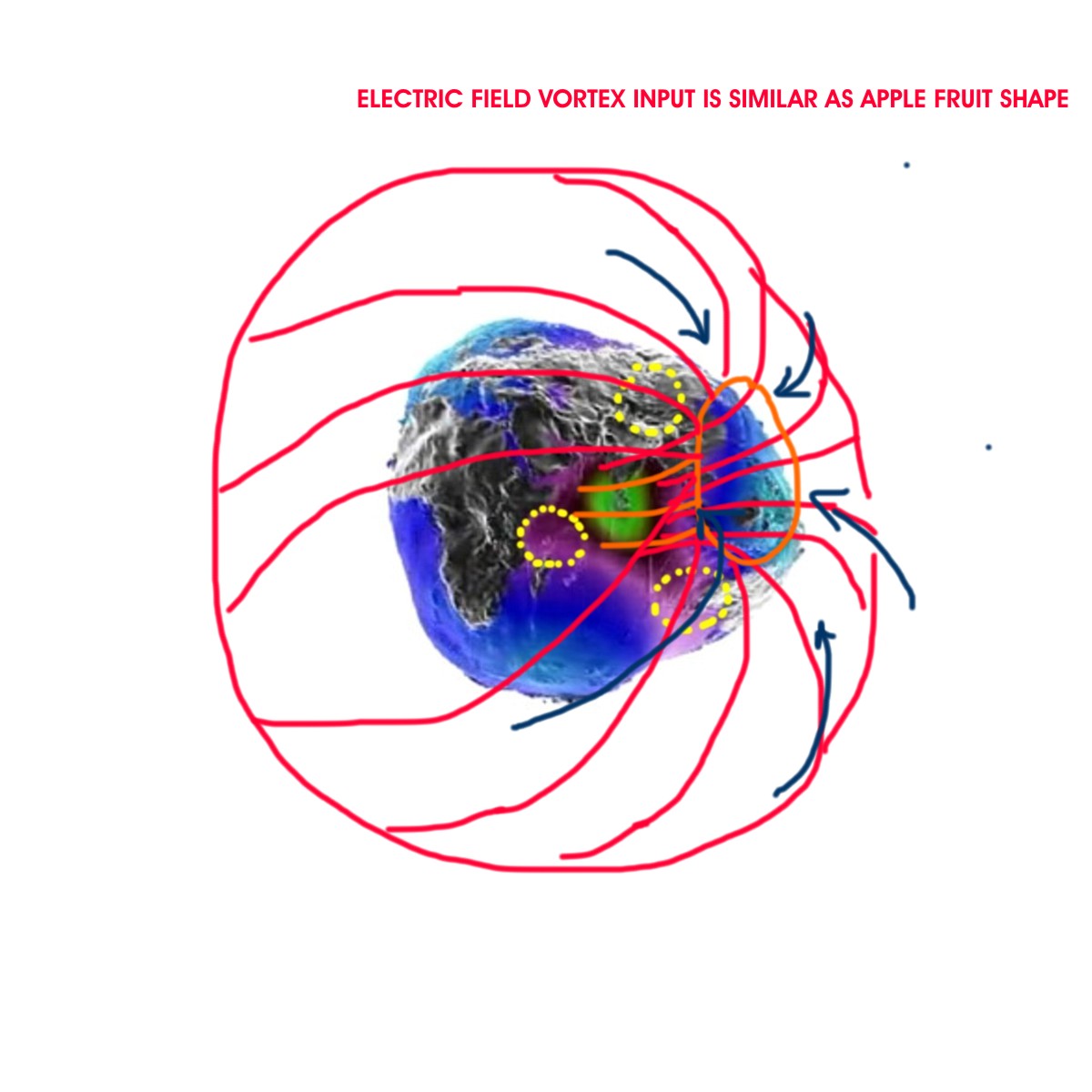
GRAVITATIONAL FORCE IMAGES FROM POSTAD GFZ.
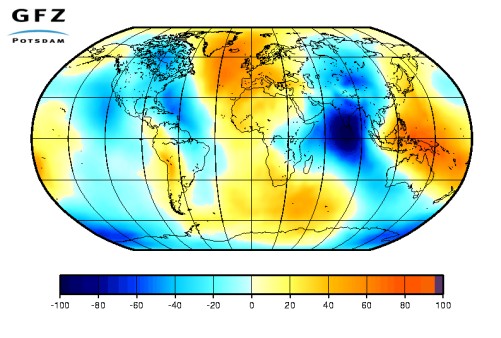
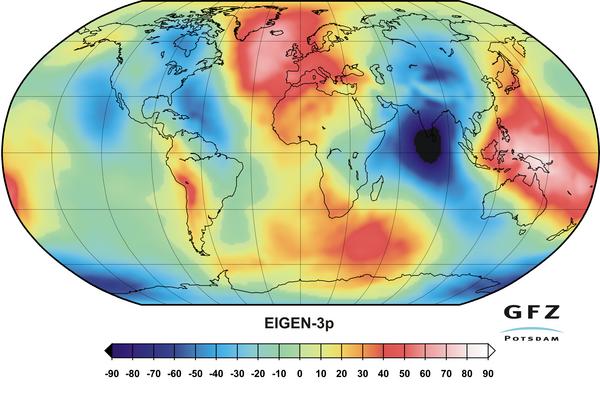
Articles and reports about
strange sound produced from planet Earth
- Strange underwater sound and burst of electromagnetic waves - a
new military weapon system or a new type of extraterrestrial UFO?
- India Daily Technology Team November 5, 2005
-
- It happened in Andaman beach areas. The fishing boats in the region
observed it. It is happening since the last year's
devastating Tsunami.
-
- Scientists believe, it is either a new military super weapon - a next
generation stealth super-sub or a new type of advanced extraterrestrial UFO that can
penetrate oceanic crust.
-
- According to scientists, the burst of
electromagnetic waves and strange sound provides some clues.
-
-
- The propagation, navigation, stealth and communication are all controlled by electromagnetic waves of unknown spectrum.
- The sound characteristic is strange.
- Any technologically advanced entity at that level is able to provide
sound shields to suppress these sounds.
-
- These sounds may be coming from electron beaming to
penetrate the oceanic crusts to build bases. It can also be caused by slow shifting of
oceanic crusts.
-
-
- Andaman is extremely active seismically. This started in July 2004 year
exactly six months before the devastating Tsunami.
In this area is US military base Diego Garcia, maybe some
idea will follow. See my computer animation for better understanding of this
possible "PLACE FOR DELIVERY NEW BABY"...
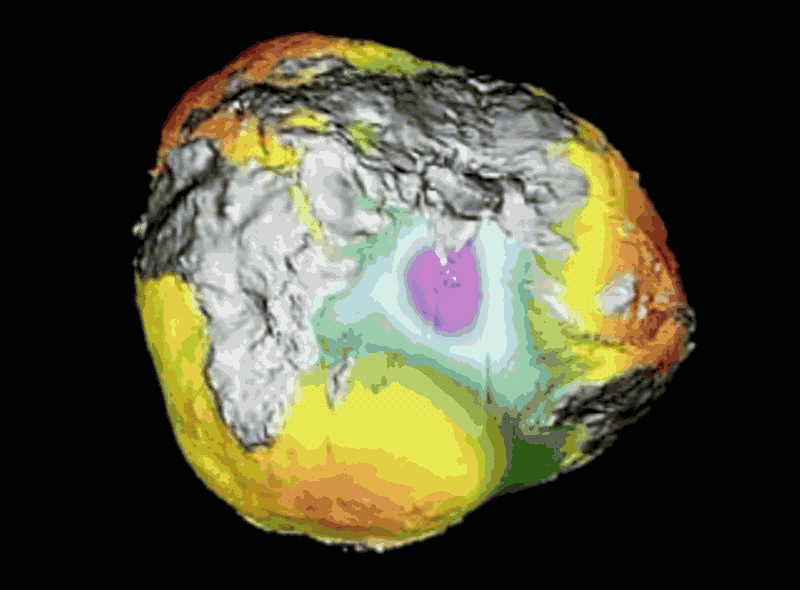
Location of USA military base Diego Garcia is
at the edge of GRAVITATIONAL HOLE.

USA military base Diego Garcia.
- When these strange underwater sound and a burst of electromagnetic waves
are experienced, no seismic tremors are recorded. No correlation between small earthquakes
and this strange phenomenon can be recognized. However, computational models exploring
numerical analysis of the stress at the plate levels are showing some clues. There is a
harmonic progression observed in the level of stresses observed in the crust levels.
-
- According to scientists, if it is true that the extraterrestrial caused
the Tsunami of the last year, it was an accident and they have perfected their
technologies not to repeat the same. The aftershocks have harmonic progression too which
means what ever is causing this instability is slowly dissipating away.
-
- Article from web site http://www.indiadaily.com/editorial/5365.asp
Hum in city of Taos, New Mexico - Possible tones of Planet Earth
The Hum' is a low-pitched sound heard in numerous places worldwide, especially in
the USA, UK, and northern Europe. It is usually heard only in quiet environments. The low
hum - between 30 and 80 Hz on the frequency scale - is often
described as sounding like a distant diesel engine idling in the distance. Since it has proven undetectable by microphones or VLF antennae, its
source and nature remains a mystery. Not everyone can hear the low-pitched hum, and those
who do say that it seems artificial in nature - and is driving them crazy.
In 1977, a British newspaper received nearly 800 letters from people complaining
of loss of sleep, dizziness, shortness of breath, headaches, anxiety, irritability,
deteriorating health, inability to read or study because of the incessant hum.
The most famous area for the tone in the U.S. is Taos, New Mexico, where the noise
often drives people crazy.
Most hearers say the noise begins abruptly, never abates, interferes with sleep
and is more noticeable inside a house or car than outside.
In 1997 Congress directed scientists and observers from some of the most
prestigious research institutes in the nation to look into a strange low frequency noise
heard by residents in and around the small town of Taos, New Mexico. For years those who
had heard the noise, often described by them as a "hum", had been looking for
answers. No one was sure when it began, but its persistence led first a few and then many
of those who heard it (called "hearers" by each other) to band together. In 1993
they found their way to Congress.
The investigation Congress requested consisted of a team of a dozen investigators
from a number of scientific institutions. Joe Mullins of the University of New Mexico and
Horace Poteet of Sandia National Laboratories wrote the team's final report. Other New
Mexico research organizations involved included Phillips Air Force Laboratory and the Los
Alamos National Laboratory. Concern by hearers that the hum might have been caused by the
Department of Defense ensured that the investigation was conducted in the open and that a
large number of persons were contacted.
The first goal of the investigative team was to interview hearers and try to
determine the nature of the hum the sound it made, its frequency, timing and its
effects on those who heard it. Next the team planned to survey residents of Taos and the
surrounding communities to determine how wide spread the hum was. Finally, the team was to
try to isolate and determine the cause of the hum. Important to their effort was the
team's clear interest in deter-mining the cause of the phenomenon, rather than questioning
the hum's existence. There was a generally clear understanding by the investigators that
something was happening here, but just exactly what it was seemed to defy definition.
The initial investigation focused on ten hearers and determined certain key facts
surrounding the hum. It was persistent. It was heard by only a small number of people. The
sound was extremely low on the frequency scale between 30 and 80Hz. There was variation
in how different hearers perceived the sound. Some heard a sound like the low rumbling of
a truck while others heard a more steady, pulsing, yet still low sound. Interestingly, the
investigators learned that the sound was not limited to the area around Taos, but was, in
fact, heard at places all over the country and around the globe.
Hearers described the increasing problems they were having with the hum.
Consistent with the reports and complaints that had brought the issue to Congress in the
first place, hearers described the hum as a cause not just of annoyance, but also of
dizziness, insomnia or sleep disturbance, pressure on the ears, headaches and even
nosebleeds. The hearers were also bothered by the disturbing nature of its existence: it
did not seem like a natural phenomenon to them.
According to the August 23, 1993 " Taos Hum Investigation: Informal
Report", most hearers initially experienced the hum with an "abrupt beginning,
as if some device were switched on." Many of the hearers believed there was a
connection between the hum, the military installations in and around New Mexico, and the
Department of Defense or that the hum was somehow caused by the U. S. Navy's ELF
(Extremely Low Frequency) stations in Northern Michigan. These suspicions made a civilian
presence on the investigation team necessary.
After examining ten hearers the team (now including James Kelly, a hearing
research scientist with the University of New Mexico's Health Sciences Center) began a
broad survey of Taos locals. Their survey of 1,440 residents led the team to extrapolate
that roughly 2% of the Taos population were hearers.
Given this large number of hearers, initial exploration of a source for the hum
focused on external possibilities for generation of the low frequency hum. While there
were isolated instances of hearing within the low frequency range identified by hearers,
these tests revealed no consistent background noise which could account for the hum. As
Mullins and Kelly concluded, there were "no known acoustic signals that might account
for the hum, nor are there any seismic events that might explain it."
Having ruled out external sources the team focused on testing hearers' inner ears
and on researching frequency sensitivity. While these investigations are not complete, it
appears highly unlikely that the hum is caused by low frequency tinnitus as some have
speculated. Mullins and Kelly are more inclined to believe that hearers have developed a
specific sensitivity to sounds in the 20 to 100Hz range and therefore are directing their
research toward gleaning an understanding of how the ear perceives low frequency energy.
While this approach may help answer the persistent question of the hum's origin,
Dr. Nick Begich and Patrick Flanagan (a Sedona-based inventor and scientist), have
explored another possibility. Dr. Nick Begich has found some interesting clues in Mullins'
own comments that might lead to another source for the hearers' unique ability and,
perhaps in the long term, a solution to their near-debilitating problem.
To support the future direction of his research Mullins has pointed out that, as a
nation, "...we're slowly building up the background of electronic noise...We're going
to more and more cordless things all electromagnetic transmitters. Whether that's the
cause of the hum, we don't know, but we can't write it off."
Begich theorizes that the cause of the hum may be found within this
electromagnetic background buildup. He believes that there is a mechanism for the
transduction of sound which might explain the hum. The key may be hidden in a technology
invented by Dr. Patrick Flanagan. NeurophonicTM sound technologies were developed based on
an understanding of sound transfer using different "hearing" pathways to the
brain. Standard sound measuring and diagnostic equipment would be ineffective in locating
the "sound" source.
Patrick Flanagan's NeurophoneTM, invented when Flanagan was 14, is a low voltage,
high frequency, amplitude modulated radio oscillator. In simpler terms, the NeurophoneTM
acts on the skin of the listener by converting "...modulated radio waves into a
neural modulated signal that bypasses the 8th cranial hearing nerve and transmits
intelligence directly into the learning centers of the brain." In other words the
NeurophoneTM allows the listener to "hear" without having to use the ear canal
or the bones and nerves we normally associate with hearing.
Flanagan's patent was approved after a six year fight with the patent office
culminating in a test of the device on a hearing impaired patent office employee. The
demonstration convinced the patent examiner that the NeurophoneTM worked, even though it
appeared to fly in the face of traditional concepts of how we hear. The novel concept with
the NeurophoneTM is that we use the skin itself as the neural transmitter.
This concept is actually quite simple. When in the womb, a fetus's skin serves as
the primary sensory organ. From it evolve the eyes, the nose and the ears. While the ears
specialize in hearing, Flanagan recognized that the skin is also an organ. Consequently,
if a way could be found to transmit information through the skin to the brain, then
information could be directly communicated to the brain, bypassing the ears. The
NeurophoneTM ran radio waves through two small electrodes placed on the skin and
essentially used existing neural pathways to directly access the brain.
Flanagan's NeurophoneTM research offers a possible explanation for the Taos hum.
As Mullins has pointed out, we are surrounded by a large number of low frequency devices
devices all operating around 60Hz. Given Flanagan's NeurophoneTM concept, it is
possible that this concentration of frequency may well be resonating with the skin causing
a direct neural link between the skin and the brain. As with the NeurophoneTM, some
individuals are more receptive than others. Consequently, some persons' skin could be more
receptive to ambient electromagnetic frequencies than others.
Flanagan and Begich speculate that the NeurophoneTM could be pulsed at the
frequencies identified by those hearers interviewed by Mullins and the investigative team.
If the hum was generated by ambient electromagnetic fields then the NeurophoneTM
technology could be used to mitigate it. While Mullins is investigating the ear canal and
our human hearing apparatus, Flanagan and Begich believe that the answer is more likely to
be found through the pathways established by the NeurophoneTM, which bypass the ear
entirely.
Proof of whether or not their theory is correct is reliant upon testing of
hearers. If Begich and Flanagan are correct, the NeurophonicTM technology and what has
been learned about hearing may well be used to alleviate the suffering of hearers as the
search for the source of the hum continues.
- By Thomas Begich - The Earthpulse Press
Source of Earth's Hum Revealed, Space Symphony Possible
March 26, 2000 - Journal Science
Competing with the natural emissions from stars and other celestial objects, our
Earth sings like a canary - it drones on in a constant hum of a gazillion notes. If it
were several octaves higher, and hence, audible to the human ear, it could probably drown
out the noise from a hundred TV talk shows. In recent years scientists have used
seismographs to sort out these subsurface sound waves from earthquakes (all seismic waves
are, essentially, the in-ground equivalent of sound waves). But what causes the hum, which
researchers call the background-free oscillation, has been a mystery.
The apparent answer, revealed in the March 24 issue of the journal Science, is as
surprising as the hum itself.
Kiwamu Nishida of the University of Tokyo's Earthquake Research Institute has,
along with colleagues, analyzed 10 years of seismic data and tied the seismic waves to
similar oscillations in the atmosphere.
Inaudible sound waves in the lower atmosphere push and pull on the ground, the
researchers say, creating coupled "sound" waves, or seismic waves, inside Earth.
The initial source, as yet not determined, could be changes in atmospheric pressure. The
researchers also did not rule out possible oceanic sources, such as pounding waves, as the
cause of Earth's hum.
The strange-but-true solution was first proposed in 1997 by Naoki Kobayashi, a
theorist at the Tokyo Institute of Technology and co-author of the new paper.
A space symphony?
Because Mars and Venus are both solid bodies with atmospheres, Nishida told
SPACE.com that our two nearest planetary neighbors are probably humming too, creating a
miniature symphony in space.
"Because the density of these atmospheres is different, amplitudes of the
'sound' might be different," Nishida said. "On the other hand, the amplitudes
[within the planets] might be similar to that of the solid Earth."
The sounds are below 10 millihertz, whereas 10,000 millihertz is about the lowest
audible to the human ear. Which means you can't hear the hum. Good thing, because the
discordant sound has been described by one geophysicist as "a very messy noise."
The sound of Mars
Philippe Lognonne of the University of Paris said a proposed future mission to
Mars, known as NetLander and expected to launch between 2005 and 2007, would explore the
seismic waves of the Red Planet and their possible connection to the atmosphere.
"We expect this signal to exist also on Mars, and to detect it will therefore
give us the possibility to see the free oscillations of Mars," Lognonne told
SPACE.com.
The NetLander mission would use a network of seismic detectors to measure
Mars-quakes - theorists expect the gradual cooling of the planet generates 50 or more
temblors a year with magnitude 3.5 or greater. Studying how the seismic waves move through
subsurface layers of different composition would help scientists determine the diameter of
the planet's core and whether it is solid or liquid.
A set of four meteorology stations would monitor the martian atmosphere and how it
interacts with the surface.
Earth Tones - background free
oscillations' of the Earth or Nikola Tesla "ethers"
September 14, 1999 - AP
They live underground. They are everywhere but seem to come from nowhere. They
barely exist, but never leave. If sounds have shadows, they are the shadows of a sound. Researchers call them the 'background free oscillations' of the Earth.
Last year, when a pair of Japanese geophysicists named Naoki Suda and Kazunari
Nawa dredged them out of a mass of seismic data, some people called them a hum.
That's a comforting thought: a mystic Om, perhaps, or just the warm, cosy sound of
a planet going about its business.
Don't try to tune in, you'll never hear it, though. The Hum is far
too low for human ears to detect and is so feeble that a single 5.5-magnitude earthquake
can blot it out. That's just as well because, if you could hear it, the Hum might drive
you mad.
"It's a very messy noise," says Hiroo Kanamori, a
geophysicist at the California Institute of Technology.
Messy because the Hum is not one note but fifty, crammed
into less than two octaves. Their pitches range between 2 and 7 millihertz.
Musically speaking, that's about sixteen octaves below
middle C.
Speeded up and amplified so you could hear it, the result would be a Stockhausenesque cacophony. Imagine sitting
down at a piano and slamming down every note within reach, while somebody next to you does
the same thing on a piano a quarter tone out of tune. "It would be like banging a
trash can," Kanamori says. Endlessly.
The individual notes are pleasant enough.
They are the natural tones that the Earth makes whenever something--an earthquake,
a meteor, a nuclear test--sets it ringing.
They are known as "free" oscillations because,
like the clang of a bell or the twang of a guitar string, they keep on sounding for a
while after their source is gone.
What's peculiar about the notes in the Hum is that they have no
obvious source. Not earthquakes, not nuclear explosions, nothing. The vibrations
triggered by cataclysmic events fade away to nothing, but the Hum
continues, regardless.
So what's the cause?
It is hard to tell because, like the tone of a bell, free oscillations sound much
the same no matter what sets them going.
The three-dimensional patterns of vibrations, known as
modes, depend mainly on how big the Earth is and what it is made of, not on what excites
them. So free oscillations reveal plenty about the layers of rock they pass
through, but are coy about their own origins.
Looking at the particular frequencies and energies does give some clues--enough to rule out the usual Earth-shaking events. So researchers
are turning to stranger ideas to explain the Earth's never-ending
mantra.
Scientists knew that free oscillations ought to exist long before they managed to detect
them. At the turn of the century, seismologists were already detecting ordinary seismic
waves--the short, sharp shocks of earthquakes--and using them to probe the depths of the
Earth. Before the First World War, physicists had proved that those relatively
high-pitched seismic waves ought to set the whole surface of the planet a-tremble with
patterns of lower-frequency standing waves. But the planetary plainsong eluded researchers
for decades.
The problem was their equipment was too crude. Even a simple seismograph can convert the
lurching motion of an earthquake into the jump of a needle. Free oscillations, however,
are much more elusive.
Not only do they vibrate much more slowly and more subtly
than ordinary seismic waves, they are also considerably more complex: three-dimensional
tangles of vibrations at scores of different frequencies and pointing in different
directions.
To identify them, seismologists must tease out all the components, using a
procedure called Fourier analysis to separate the different frequencies. The calculations
are straightforward but too tedious to undertake by hand. By the late 1950s computers had
solved that problem, but seismic detectors still weren't sharp-eared enough to pick up the
oscillations from normal-sized sources.
Then nature let loose a blast nobody could miss. On 22 May 1960, the most powerful
earthquake ever recorded struck southern Chile. The quake, now rated
at magnitude 9.5, set the Earth's interior jangling.
Earth scientists scrambled to dissect the vibrations and
discover what they could tell about the Earth's vibrational modes, and the elasticity and
density of its interior.
In the decades that followed, seismometers grew ever more sensitive. By the 1970s and
1980s, global networks of seismic stations were monitoring the vibrations of the Earth
round the clock, and any seismologist or geophysicist craving information could download
it as easily as turning on a tap. Over and over again, geoscientists witnessed a classic
pattern: the shriek of an earthquake striking a resounding chord of free oscillations.
Meanwhile, between earthquakes, the Earth hummed away unnoticed.
The vibrations were there, all right; they were just extremely subtle. Rudolf
Widmer-Schnidrig, a German geophysicist at the Scripps Institution of Oceanography in
California, calculates that the power of the Hum is a mere 500 watts
worldwide--barely enough to run five ordinary light bulbs.
Even so, by the 1980s seismic instruments were perfectly capable of detecting it,
and they did. Background free oscillations were plainly visible, for
example, in the noise plots researchers used to gauge the quality of seismometers.
But geophysicists paid the oscillations no more heed than the background hiss of a vinyl
record.
The Hum almost came to light in the late 1980s, when a team at the
Massachusetts Institute of Technology noticed that the Earth was oscillating even when
there had been no earthquakes to set it in motion. The
investigators decided that the vibrations must be due to "slow" or
"silent" earthquakes, mysterious seismic events that were thought to release
energy gradually, without any faults rupturing. Unable to pin down where the
supposed slow quakes were taking place, however, the MIT researchers lost interest. The
Hum never crossed their minds.
Then, in 1997, Suda and Nawa came on the scene and turned things upside down. Instead of
starting with oscillations and looking for earthquakes to explain them, they looked
between the earthquakes for oscillations they couldn't explain. Suda, a seismologist then
at Nagoya University, and Nawa, then working on his doctorate under Suda's supervision,
took their inspiration from a little-noticed paper by Naoki Kobayashi, a theorist at the
Tokyo Institute of Technology. Kobayashi predicted that the Earth's atmosphere ought to
excite free oscillations in the Earth. Suda and Nawa set about finding them.
Nawa had just spent a year at Japan's Syowa Station in Antarctica, tending
a device called a superconducting gravimeter. The instrument
had been installed to look for a controversial hour-long oscillation of the Earth's core,
but it could also pick up shorter-period vibrations. Suda suggested that Nawa check
its records for evidence of unexplained free oscillations.
Meanwhile, Suda combed through archived data from seismic stations around the world. Then
they started crunching numbers.
"It's actually not that sophisticated, which is why those of us who didn't do this
can all be moderately embarrassed," says Duncan Agnew, a geophysicist also at the
Scripps Institution of Oceanography. "You take the stations with the lowest noise.
You take the days when there are no earthquakes. For each day, you take a Fourier
transform of the data, which shows the distribution of energy with different frequencies.
And then you simply add up all the days."
The result was a jagged graph showing a series of "spectral
peaks", the frequencies at which the Earth oscillated in the lulls between large
earthquakes. Nawa and Suda then subtracted everything that they could account for
by known sources, including a theoretical estimate of the effects of earthquakes small
enough to slip through the seismic net. They wound up with a residue of faint vibrations
with no known source: the Hum. Nawa and Suda announced their results in 1998, and other
researchers quickly confirmed them. The vibrations, it turned out, had been buzzing in
their ears all along.
"The mystery is, where do they come from?" says
Gem, a geophysicist at Harvard University. Ekstrum and most other
geophysicists hope they have an underground source that might reveal something new about
the depths of the Earth: slow earthquakes, the rumbling of tectonic plates or some exotic
seismic process in a little-studied part of the Earth, such as oceanic fracture zones -
places where the seafloor is being ripped apart in a complicated pattern of faults.
Earthquakes, an early favourite, started to lose their lustre on closer examination. When
an earthquake strikes, it pounds out a chord made of frequencies from all the vibrational
modes at the same time. In the Hum, by contrast, individual "notes" constantly
drop out and reappear -a different style of music. For a while, deep-earth enthusiasts
took heart from a strange signal in Nawa's Antarctic recordings. The gravimeter picked up
oscillations with periods as long as 54 minutes--too long, in theory, to have been
produced near the surface of the Earth. But those signals have not shown up in any other
data, and Suda now thinks they must have come from a source at or near Syowa Station,
perhaps buildings shuddering in the wind.
Now geophysicists are considering the possibility that the Hum could be generated above
ground--and has little to do with their beloved rocks. Take the oceans. For seismologists
listening for earthquakes, the pounding of surf along the world's coastlines is a constant
annoyance.
As waves crash onto the shore they create a 6-10 second thrum that can drown out
the crackle of slipping faults. Some of that energy might excite the longer-period modes
that make up the Hum. At present, though, oceanic sources look like a long shot. The smart
money seems to be on Kobayashi's original bet, the atmosphere.
Could thin air really pack enough punch to turn the Earth into a huge aeolian harp?
Easily, says Toshiro Tanimoto, from the University of California, Santa Barbara, a key
proponent of the atmospheric-excitation hypothesis. The atmosphere receives enough energy
from the Sun to keep the Earth humming thousands of times over.
In Tanimoto's opinion, the humming starts with drumming, the constant throb of fluctuating
atmospheric pressure all over the Earth. When air pressure rises, the atmosphere presses
down slightly harder on the ground or sea beneath it. When the pressure drops, the surface
gently rebounds. In other words, the world is like a gong being constantly buffeted by
countless soft rubber mallets. And at any given moment, some of them will be tapping at
the right frequencies to excite the modes that make up the Hum.
Tanimoto has worked out exactly how energy from the atmosphere could
be converted into the oscillations Suda and Nawa observed. His model predicts that
the sounding of the global gong ought to vary over the course of a year, peaking in
winter, when atmospheric pressure is highest and the airy mallets hit hardest.
To test that prediction, Tanimoto analysed readings from 15
exceptionally quiet seismic stations scattered around the globe. By adding together
spectral peaks from many years' worth of records, he amplified the vibrations until he
could see subtle changes in their intensity. At each station
Tanimoto checked, the Hum grew about 10 per cent louder between December and February and
between June and August - winter in the northern and southern hemispheres respectively.
That twice-yearly rise in volume is the clincher, he says.
"Processes in the solid Earth cannot possibly explain seasonal variations. There may
be some slow movements of the Earth, but they don't happen in a seasonal fashion."
And Suda has recently found evidence that the Hum also varies over the course of a
day--further support for a source above ground.
An air-driven hum would be ho-hum for geophysicists, because it probably could not tell
them anything they haven't already learned from the louder, cleaner signals of
earthquakes. But even if continuous free oscillations turn out to be of no earthly use,
they may have unearthly ones. After all, if the Hum starts in the atmosphere, then other
planets with atmospheres ought to hum, too, and some researchers think background free
oscillations could be just the ticket for studying their interiors. That's particularly
likely to be true of a cool, tectonically dead planet such as Mars. Marsquakes are thought
to be rare, but the Martian hum, if it exists, will always be turned on--faint, but
available.
Philippe Lognonné, a geophysicist at the Institute of the Physics of the Earth in Paris,
is in charge of coordinating the experiments for the first mission to explore Mars's
geology. The Netlander mission, due to be launched in 2005, will place four seismic
stations on Mars. Broadband seismometers will record a wide range of vibrations, including
those likely to be found in a Martian hum, and relay the information back to Earth for one
Martian year (about two Earth years).
To get some idea of what to expect, Lognonn and Fran Forget, an atmospheric scientist at
the Pierre and Marie Curie University of Paris, are creating computer models of the
Martian atmosphere and the free oscillations it might kick up inside the planet. Though
the air on Mars is much thinner than that on the Earth, Lognonné says, the violent winds
that tear across the Red Planet's surface ought to set Mars ringing, too--possibly as
loudly as the Earth does. And with less background noise to interfere, the vibrations may
be easier to detect. If so, they could give valuable information about the planet's
mantle, about which next to nothing is known.
HOW WE BORN SEE HERE
-
INDEX
Prava kopiranja ©. 2015. Sva prava pridržana. Rudolf Bošnjak.
Copyright ©. 2015 All rights reserved.
Rudolf (Boschnjak) Bosnjak. |
www.bev.ba
www.elektroauto.ba |
 
|
|


















